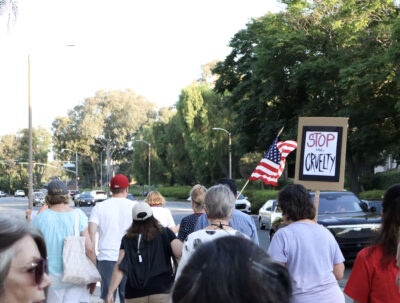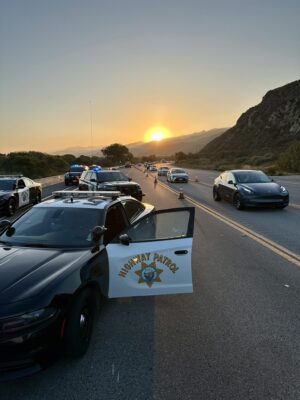After the William S. Hart Union High School District made the decision to use virtual learning as the new norm due to the ongoing pandemic, teachers in the district were given the option of whether they wanted to stay at home to teach or go into the classroom.
The expectation was that the choice would not affect the level of education students received, and the professionalism teachers exhibited, according to district officials.
Close to 50% of the teachers district-wide elected to stay home while the other 50% decided to go into the classroom. The reasons have differed for each teacher’s individual decision, from being health-conscious to having kids at home who are also now distance learning.
At Golden Valley High School, the split is closer to 30% of teachers returning to campus, while the other 70% made the decision to stay home.

“We love being around the kids, we love being around the staff,” said Principal Sal Frias, who has more than 30 years of experience in education. He added that things that used to take him only a few minutes or one conversation to convey now take a lot longer due to the need for distanced, electronic communication techniques. “It’s just different and frustrating,” he added.
The Hart district invited The Signal to speak with teachers sharing their experiences from the two different virtual environments. In the Grizzlies’ math department, for example, teacher Nicholas Patey uses the technology in his classroom, while math teacher Beth Flynn teaches from home.
Teaching from school
Frias described walking onto the Golden Valley campus during a pandemic as “eerie,” compared to usual operations. It was even stranger before some of the teachers returned, he said.
Teachers on campus are asked to come in as much as 30 minutes early to ensure enough time for a battery of questions from the school nurse, regarding symptoms, any potential exposure and more. Temperatures are then taken before one can walk into a classroom or down a hallway.
The teachers then set up in isolation in their respective classrooms. Around Patey’s classroom there still hang projects from last year that were done in class, unused Expo markers around white boards used for group activities, and the desks in the classroom have already been spaced apart in anticipation of the blended model return.

Students then log on.
Patey — who teaches a number of math-related courses, including AP calculus — requires that his students, like many teachers around the district, have their cameras on, but their audio turned off unless they have a question.
Approximately 30 heads in small boxes, some picture frames at eye-level while others show images of faces from phones laid down on their desks pointed upwards, are displayed in front of him, listening to him speak, asking questions along the way.
On Thursday, Patey walked students through “Squeeze Theorem,” which gives you the limit of a function. While teaching, sitting at his normal teacher’s desk in his classroom, he shares his Zoom screen with the students, and then proceeds to write out the problems using his tablet and stylus.
Patey says he can’t read his students’ body language or attitudes through Zoom as he could when they came into the classroom, making it more challenging to teach, he said. But he’s found some workarounds, such as placing calls or allowing them to ask him questions before ending the online session.
“That’s the most frustrating part is the lack of personal connection in class, because I can easily have that just by standing next to a student or shaking their hand as they enter the door,” Patey said. “So, what I try to do is have multiple opportunities for them to give me feedback.”
When asked if there were any positives that have come out of distance learning, Patey hesitated, then said he would appreciate his time with his students far more than he already does, and has for his 13 years of teaching.

“I mean, I won’t take that for granted again. I like to see my students every day, in person,” he said.
Teaching from home
The struggle of it not being as easy to make connections with students is almost universally felt by teachers, whether teaching from home or teaching from the classroom, Flynn said.
“Those moments that they come in before the bell rings, or they’re cleaning up after the ending bell rings and then leaving, those moments are just so precious,” Flynn said in response to how she has bonded with students in her more than two decades of teaching in a traditional classroom. “You can really make connections with students … so I’ve had to adjust on that, as well.”
Patey said he decided to go in to work because his wife is also a teacher and needed a workspace. Additionally, he has three kids who are also doing distance learning of their own. The decision to come in is as much logistical as it is about having deadlines that he makes for himself.
Flynn decided to stay home to teach due to, in addition to the concern over COVID-19 exposure, her high school daughter being at home and doing distance learning. Between classes, if there are no papers to grade or students to speak with, she can easily take care of the laundry or make herself lunch.
However, in order to make this possible, Flynn had to put work into creating her at-home workspace. Wires, textbooks and a tablet surround the two-monitor setup she looks at while wearing a headset and sitting at her dining room table.
“In March, it was just so shocking, and we just really didn’t have a whole lot of time to think about those things,” said Flynn, who added she was working in the spring at her kitchen table with only a laptop, as opposed to her current high-tech setup.
“Now the students and the teachers, I think, feel a little bit better,” she said
Both teachers are utilizing breakout sessions on Zoom, planning their curriculum around distance learning, and ensuring that students have access to them through various means of communication.

Flynn has been able to get around not being able to read a student’s body language every day by running mental wellness activities and check-ins. One such activity allows the students to inform her how they’re feeling at a particular point in time.
The teacher has also added, she said, more Google Form sheets to the class, allowing students to provide her with “constructive criticism” on what is working for them and what is not in terms of the websites and programs and activities Flynn is running.
Flynn, Patey and Frias all said the big component distance learning was having trouble making up for, outside of the pupil-student connection, was that the kids miss socializing with one another.
“As long as we all keep on doing our part … we can get back to our blended model so that we can get back to a full return,” said Frias.






